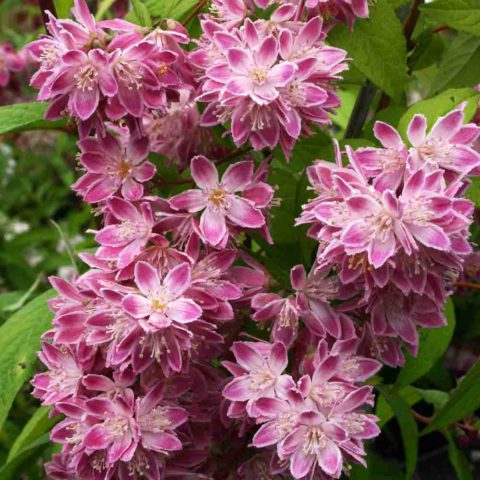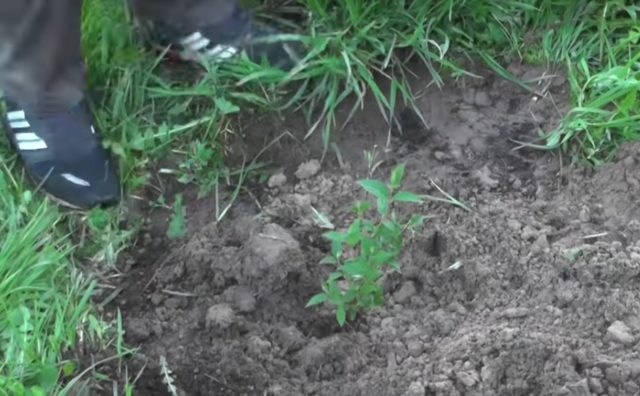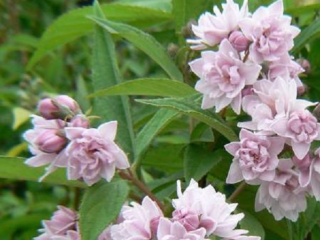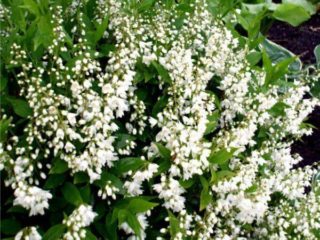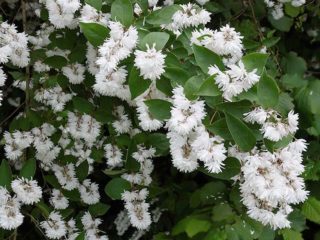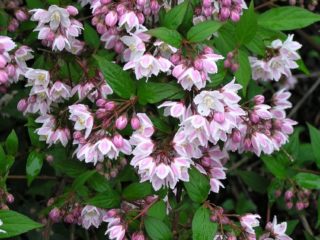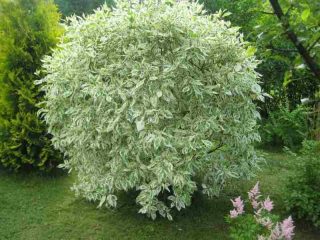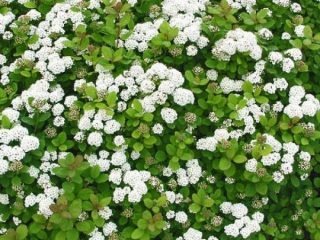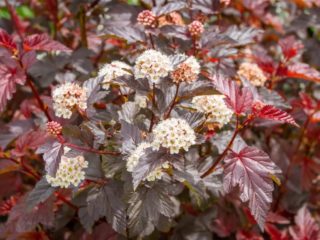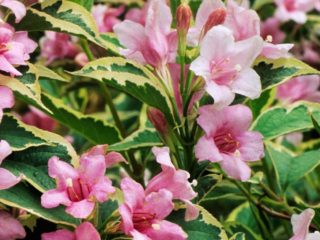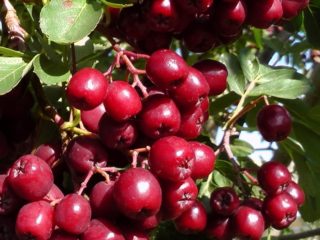Content
Deutzia is a perennial plant belonging to the Hydrangeaceae family. The shrub was brought to Northern Europe at the beginning of the 18th century by merchant ships from Japan, where the plant adorned the imperial gardens. The main varieties, which later formed the basis for decorative breeding forms, came to France and England in the mid-19th century from China. Hybrid deytsia Strawberry Fields is one of the few varieties of crops that can adapt to Russian climatic conditions.
Description of the Strawberry Fields action
The garden form of Deutia Strawberry Fields (pictured) is a deciduous tree-like plant popular among landscape designers and florists. A shrub 1.5 m high with a dense, spreading, voluminous crown formed by numerous thin shoots. The main growth occurs in the first three years of the growing season; deutzia adds 20-25 cm in height and width.The culture is perennial, the average duration of the biological cycle is 25 years.
Description of the Strawberry Fields action:
- The crown is rounded, spreading, the shoots are thin, tubular, hollow, arched with drooping tops, the first stems are low-lying, often bending down to the ground surface under the weight of the inflorescences. Perennial branches are gray with peeling bark, young stems are olive in color.
- The leaves are light green, arranged oppositely, in the shape of an elongated oval with a sharp tip. The length of the leaf blade is about 7 cm, the leaves have serrated edges and a rough surface. In autumn, the foliage turns yellow.
- The root system is of a mixed type, the central roots are deep, the lateral fibrous superficial.
- The seeds are small, dark beige capsules that ripen at the end of August.
How the hybrid Deutia Strawberry Fields blooms
Deutia Strawberry Fields blooms for 2 months from June to July. Buds are formed from leaf axils along the entire length of last year's shoots. Flowering is abundant. The flowers are large, five-petaled, collected in panicle inflorescences.
The coloring of the flower makes it decorative. The outer side is light burgundy, the inner part combines all shades of pink. The petals at the base and along the edge are light, closer to the top the tone darkens, turning into a bright, dark pink fragment. The anthers are yellow, located on white filaments.
Deutzia Strawberry Fields becomes decorative during flowering. The shrub is used in landscape design for lining tree groups, as a tapeworm, and to create a hedge.Used for landscaping gardens, backyards, and summer cottages.
The Strawberry Fields hybrid, planted in a rock garden, gives the rock garden an oriental flavor and a complete look. The culture is used to make bouquets and included in compositions with various types of flowering plants. The photo shows Deutia hybrida Strawberry Fields during flowering; the exotic beauty of the plant will not leave even the most experienced florist indifferent.
Features of reproduction
According to reviews from gardeners, the Strawberry Fields hybrid deutia can be propagated in any available way. During generative breeding, the characteristics of the parent plant are completely preserved. The germination rate of the seeds is high, young shoots growing by self-sowing near the bush are suitable for replanting. You can grow seedlings yourself or increase the number of deutia bushes vegetatively.
Propagation methods for Strawberry Fields action:
- Planting seeds. The material is harvested in early autumn and sown in a mini-greenhouse or container in the spring. After 20 days, shoots will appear, when the seedlings grow to 5-7 cm, they are dived into separate containers or a larger container. Plant Strawberry Fields deutia on the site at the end of next spring.
- By cuttings, which are harvested from the top of last year's shoots in early August. By this time the action will have faded. The length of the planting material is 15-25 cm. The sections are treated with a growth stimulator and placed in a fertile substrate. By spring, the cuttings will take root and be ready for planting.
- By layering. Work is carried out in the spring, when the soil has warmed up to +6 0C. Make a furrow 10 cm deep near the bush, bend the lower perennial shoot into it, and secure it with metal staples. The furrow along with the shoot is covered with soil from above.At the end of July the number of plots will be visible. The material is cut and planted in a permanent place. Shelter for the winter.
The material is planted in the spring, the first flowers will appear next year.
Planting and caring for hybrid action Strawberry
The hybrid form of Deutzia Strawberry Fields is an unpretentious plant if the planting time and correct subsequent agricultural practices are observed; the shrub takes root well in a permanent place and begins to bloom at 3 years of age.
Recommended timing
The timing of planting Strawberry depends on the weather conditions of the region. In the South, ornamental shrubs are planted in the spring, approximately in mid- or early April; autumn planting is carried out a month before the onset of frost in October.
The winter hardiness of Strawberry Fields is average; autumn planting in regions with a temperate climate is not considered, since young seedlings will not have time to fully take root before frost, and even with the most conscientious shelter they will not be able to survive the winter. Deutzia Strawberry is planted in the spring at the beginning of May, the timing is relative, it is different for each area. A prerequisite is that the soil temperature must not be lower than +60C.
Site selection and soil preparation
The root system of Strawberry Fields is of a mixed type: the superficial one provides the plant with nutrients, the deep one provides the necessary moisture. This feature is taken into account when choosing a location; the site should be well-drained, without stagnant or close-lying water. Deutzia Strawberry is a light-loving plant; lack of lighting affects the growing season; in the shade the color of the flowers is pale and they are smaller in size.Hybrid Strawberry Fields does not withstand wind well; the branches are hollow and brittle. The landing site is chosen on the south or east side, protected from drafts and strong gusts of wind.
Deutzia Strawberry Fields will not grow on acidic or slightly acidic soils; the composition must be neutral, slightly alkaline is allowed. If the soil is acidic, add lime to the hole when planting. Pre-prepare a nutrient substrate, mix 1 part of humus or compost with two parts of turf soil, add ¼ part of sand.
The photo shows an annual seedling of Deutia Strawberry Fields, which, subject to planting technology and proper care, will bloom next season.
How to plant correctly
Before planting, you need to take care of the material for the drainage cushion. Use pebbles, gravel, broken brick or expanded clay. You will need material of a larger fraction and a finer one.
Strawberry Fields Landing:
- Dig a hole with a diameter of 50*50 cm, guide it by the size of the root, the distance to the walls of the hole should be free by about 15 cm. Depth - 65 cm, if the seedling is small and the hole is deep, add more nutrient substrate.
- A 10 cm layer of coarse material is placed on the bottom, and the same amount of fine material is placed on top. Pour a layer of the prepared nutrient mixture, taking into account that after planting the root collar remains on the surface.
- The deutia seedling is placed in the center, a layer of substrate is poured, compacted, and watered.
Growing rules
Deutzia hybrid Strawberry Fields does not require special attention from the gardener. Caring for a beautiful flowering shrub is standard.Deutzia is used for decorative landscape design, so the shrub must have a well-formed crown and bloom profusely. If you follow certain rules, there will be no problems with growing.
Watering
Deutzia Strawberry Fields is a drought-resistant plant; it tolerates moisture deficiency much better than excess. The monthly water consumption rate for an adult shrub is 12 liters. Watering is oriented towards seasonal precipitation. In seedlings, the central root is not yet deep enough to fully support the plant. Up to 2 years, water the deutia 2 times a month with a small amount of water.
Mulching and fertilizing
Mulching for Strawberry Fields is a mandatory measure, relevant at any age. The covering layer prevents weeds from growing, retains the necessary moisture, protects the root system from overheating, and a layer of colored wood chips or bark serves as a decorative element. For mulching, peat, sawdust, straw, and crushed conifer cones are used. In autumn the layer is increased with needles, in spring the material is completely renewed.
Fertilizing of Strawberry Fields begins during flowering. In the spring, when buds form, add compost and ash. At the beginning of flowering and after 1 month, the bush is fertilized with complex mineral products. Young seedlings do not need additional nutrients; the fertile substrate added during planting is enough for them.
Pruning rules
During the spring-summer season, pruning of Strawberry Fields is carried out twice. The first is sanitary in nature, the second is formative. In the spring, before the sap flows, remove twisted, frozen stems and cut off dry areas. They get rid of last year's shoots with the tops tilted inside the bush. The crown is formed after flowering.All stems are shortened to the first strong branches, 2 buds are left on them, the rest is cut off. Until autumn, the shrub will produce young shoots that will bloom the next season. Every 4 years, rejuvenating pruning is carried out, removing old stems.
Preparing for winter
The degree of winter hardiness of the hybrid Strawberry Fields is not so high that the plant can withstand low temperatures without loss. With an indicator of -28 0C and below, without preliminary measures taken, the crop may not survive the winter, especially seedlings. The stems of young bushes are carefully bent to the ground and secured. Install arches with stretched lutrasil or spunbond, cover with leaves on top. The stems of adult Strawberry deutia cannot be bent down; they are fragile and break easily. The shoots of the bush are collected in a bunch and tied with twine or rope. I wrap it in burlap on top, install supports in the form of a hut around the bush, and put spruce branches on them.
Pests and diseases
Hybrid varieties of deutia differ from varietal representatives of the culture in their high resistance to infection. If the planting site is chosen correctly and the care conditions are followed, Deutzia Strawberry does not get sick. If the soil becomes waterlogged, the root system may rot; in this case, it is necessary to reduce watering or move the shrub to another location. In the shade with high humidity, spots appear on the leaves. Get rid of fungus using products containing copper.
The only pest that parasitizes Strawberry Fields is the bumblebee proboscis; the insect's caterpillars feed on the leaves. Treat the plant with Kinmiks or Decis.
Conclusion
Hybrid Deutzia Strawberry Fields is one of the varieties of crops grown in Russia.The plant is drought-resistant and tolerates moisture deficiency well. Frost resistance allows the use of Strawberry for landscape design in a temperate climate zone. The shrub retains its decorative properties during the period of abundant flowering (for two months). The hybrid is undemanding to care, has a strong immunity to infections, and is practically not affected by pests.

